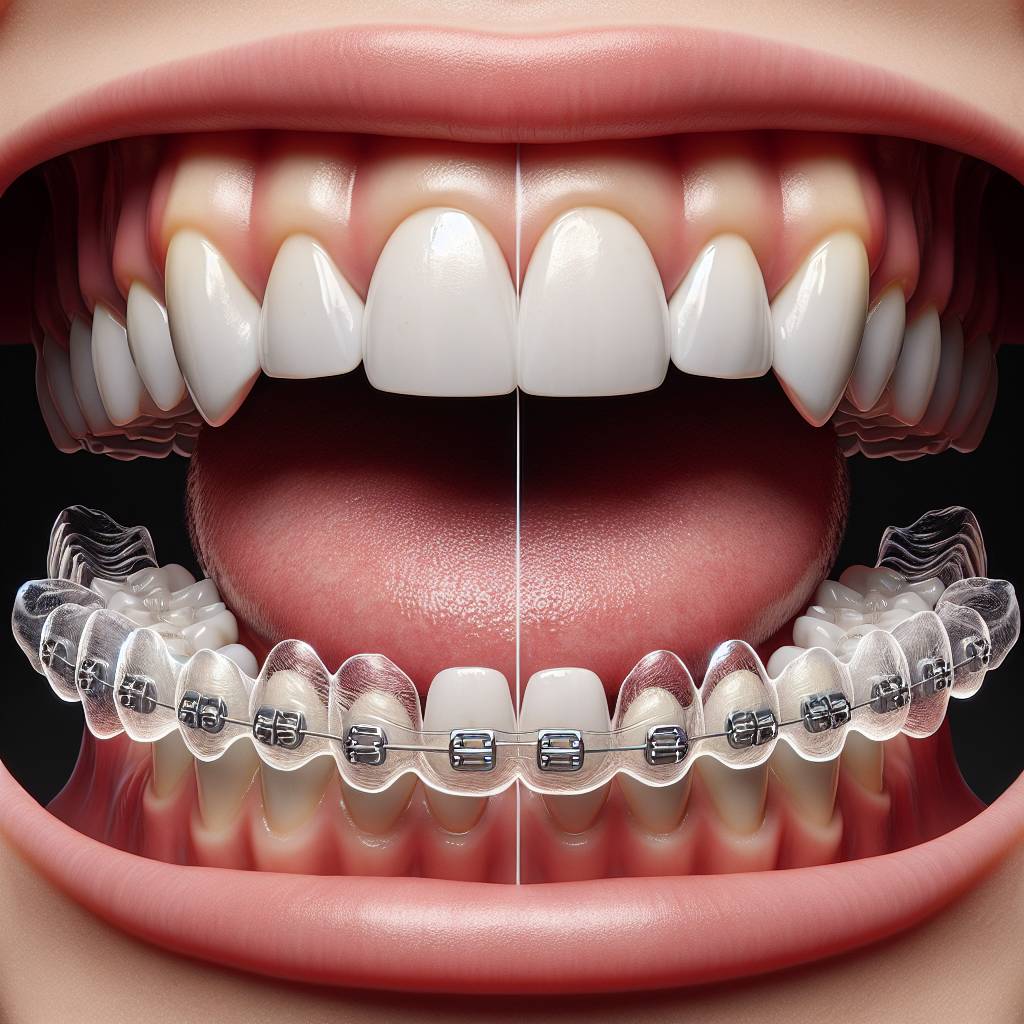Aligners are an increasingly popular treatment for straightening teeth. They are custom-made, removable appliances that fit snugly over the teeth and gently move them into their desired position over time. Unlike traditional braces, aligners are nearly invisible and can be easily removed for eating, brushing, and flossing. Aligners can help correct a range of dental issues including misaligned teeth, overcrowded teeth, or gaps in between teeth. By gradually shifting the teeth into the correct position, aligners can help you achieve a straighter and more balanced smile.Aligners are clear, removable orthodontic devices that are designed to gradually move teeth into the desired position. They work by applying gentle pressure to the teeth which encourages them to shift into the correct alignment. Each aligner is custom-made to fit your teeth and is typically worn for two weeks before being replaced with a new one. As each aligner is changed, the teeth continue to be gently pushed into their desired position until the desired result is achieved.
What Types of Aligners Are Available?
Aligners are clear braces that are used to straighten teeth and correct misalignment. They are an increasingly popular alternative to traditional metal braces, as they are almost invisible when worn, more comfortable, and require less frequent visits to the orthodontist. There are a number of different types of aligners available on the market today, each with its own advantages and disadvantages.
The most common type of aligner is the Invisalign aligner system. This system uses a series of customized plastic trays that fit over the teeth to gradually move them into proper alignment. Invisalign is highly customizable and can be used to address a wide range of dental issues, including overcrowding, gaps between teeth, and crooked or misaligned teeth. The trays can be removed for eating and cleaning and can be adjusted as needed by dentists or orthodontists.
ClearCorrect aligners are another popular option. These clear plastic trays use 3D imaging technology to customize each tray for optimal fit and comfort. ClearCorrect trays must be worn for at least 22 hours per day in order for them to be effective, but they do not require frequent visits to the dentist or orthodontist for adjustments like other types of aligners do.
Traditional metal braces are still an option for those who need more intensive orthodontic treatment or who cannot wear other types of aligners due to certain medical conditions or lifestyle factors such as allergies or extensive sports participation. Metal braces involve brackets attached to the front of each tooth that move the teeth into position over time with regular adjustments from an orthodontist.
No matter what type of aligner you choose, it’s important that you follow your dentist’s instructions carefully in order to achieve optimal results. With proper care and maintenance, you can have a beautiful smile in no time!
How Long Do Aligners Take to Straighten Teeth?
Straightening teeth with aligners is a popular and convenient option for people who want to improve their smile without the hassle and discomfort of traditional metal braces. The length of time it takes to straighten teeth with aligners depends on the severity of the misalignment, the number of aligners used, and how often they are worn.
On average, it takes approximately six months for an adult to straighten their teeth with aligners. This timeline includes about 20-30 aligners that are switched out every two weeks. In more severe cases, it may take up to a year or more to complete the process. In some mild cases, patients may only need 8-10 aligners that can be completed in as little as three months.
When wearing aligners, it is important to keep them in for at least 20-22 hours per day in order for them to be effective. If they are not worn consistently or if the patient does not follow their treatment plan as prescribed by their dentist or orthodontist, then the treatment time could be extended or even become ineffective altogether.
It is also important to note that even after treatment is finished, patients will need to wear a retainer for several months in order to maintain their new smile. Retainers should be worn at night and can help ensure that your teeth stay straight over time.
Overall, straightening teeth with aligners usually takes six months on average but can vary depending on the severity of misalignment and adherence to wearing them consistently. Following your dentist or orthodontist’s instructions and wearing your retainer as prescribed will help ensure that you achieve great results from your treatment.
How Are Aligners Different from Braces?
Aligners and braces are both orthodontic treatments used to straighten teeth, correct bites, and improve the overall look of a smile. However, there are some key differences between the two that patients should consider before choosing a treatment option.
Aligners are made from clear plastic and fit snugly over the teeth. They are almost invisible when worn, making them more aesthetically pleasing than traditional metal braces that can be seen when smiling. The aligners also need to be replaced every two weeks as the teeth gradually move into their new positions.
Braces use metal brackets and wires to apply pressure to the teeth and gradually move them into place over time. The brackets are connected with wires that can be adjusted by an orthodontist during regular appointments. Braces are more permanent than aligners since they cannot be removed until the treatment is complete, usually after one or two years.
Another advantage of aligners is that they are removable for eating and brushing your teeth, which makes it easier for patients to maintain good oral hygiene while undergoing treatment. Braces can make it difficult to brush and floss due to small spaces between wires and brackets that can trap food particles.
Both aligners and braces require regular visits with an orthodontist in order for them to work properly. The cost of both treatments will vary depending on the severity of the case, but generally braces tend to be more expensive than aligners due to their complexity and longer treatment duration.
Ultimately, it is up to each individual patient to decide which option is best for them as both treatments have their own advantages and disadvantages. It’s important for patients to consult with an orthodontist who can review all available options before making a decision about which treatment is right for them.
What Are the Benefits of Using Aligners over Braces?
Aligners have become an increasingly popular option for those seeking orthodontic treatment. Aligners offer a number of advantages over traditional braces, making them an attractive choice for many people. Some of the key benefits of using aligners over braces include convenience, comfort, and improved aesthetics.
Aligners are much more convenient than braces. They are removable and easy to clean, making it easier to maintain good oral hygiene. Additionally, aligners are much less intrusive than braces and can be removed when eating or drinking, making them an ideal choice for adults who don’t want to commit to permanent orthodontic treatment.
Aligners are also much more comfortable than braces. Traditional metal braces can cause irritation on the inside of the mouth as they rub up against the gums and cheeks while aligners cause no such discomfort. Additionally, aligners need to be worn for shorter periods of time than traditional braces, meaning that they will not cause as much discomfort in the long run.
Lastly, aligners offer improved aesthetics compared to traditional braces. Aligners are made from clear plastic which makes them almost invisible when worn in the mouth. This makes them a great choice for adults who may feel self-conscious about wearing traditional metal braces or who want to maintain a professional image at work or at social events.
In conclusion, using aligners instead of traditional braces offers a number of benefits including convenience, comfort, and improved aesthetics. For many people seeking orthodontic treatment, aligners offer an attractive alternative to traditional metal braces.

How Much Do Aligners Cost?
Aligners are a popular orthodontic treatment option for achieving a straighter smile, but how much do they cost? The cost of aligners depends on several factors, including the complexity of your case, the type of aligners you choose, and the length of your treatment. Generally speaking, aligners range from $1,800 to $7,000 in total.
The complexity of your case is an important factor because it will determine how long you need to wear aligners and how many sets of aligners you will need. For example, if your teeth are already relatively straight and only require minor adjustments, then your treatment may be shorter and require fewer sets of aligners than a more complex case.
The type of aligners you choose also affects the cost. There are two main types: clear plastic aligners and metal braces. Clear plastic aligners tend to be more expensive than metal braces because they are made from medical-grade materials that provide a better fit for your teeth.
Finally, the length of your treatment will affect the overall cost. Most treatments last between six and eighteen months but this could vary depending on your case. The longer the treatment, the more sets of aligners you will need and the higher the overall cost will be.
Overall, the cost of aligner treatments can vary greatly depending on several factors such as complexity of case, type of aligner chosen and length of treatment. Generally speaking, total costs range between $1,800 to $7,000 for most cases.
Potential Side Effects of Using Aligners to Straighten Teeth
Aligners are a popular and effective way to straighten teeth. However, just like any other orthodontic treatment, they can have potential side effects. The most common side effects associated with using aligners to straighten teeth are irritation of the gums, cheeks, and lips; temporary speech impediments; and difficulty eating or drinking certain foods.
Irritation of the gums, cheeks, and lips is the most frequent side effect experienced by patients who use aligners to straighten their teeth. This is because the aligner trays are slightly larger than the teeth, causing them to rub against the soft tissue in the mouth. This can cause discomfort and soreness in these areas. It is important for patients to follow their orthodontist’s instructions regarding how long they should wear their aligners each day, as this will help reduce discomfort in the mouth.
Using aligners to straighten teeth can also cause temporary speech impediments. This is because the aligner trays cover part of the tongue and can affect how a person speaks. It is important for patients to be aware that this may happen so that they can adjust their speech accordingly until they become accustomed to wearing their aligners.
Finally, using aligners to straighten teeth may also make it difficult for some people to eat or drink certain foods or beverages due to the size of the trays blocking access to certain parts of the mouth. Patients should be aware that this may be an issue when they begin treatment and adjust their diet accordingly until they become used to wearing their aligners.
Overall, while there are potential side effects associated with using aligners to straighten teeth, these effects are usually minor and temporary in nature. Patients should follow their orthodontist’s instructions carefully in order to minimize any potential discomfort or inconvenience associated with using these devices.
Are There Any Alternatives to Using Aligners to Straighten Teeth?
When it comes to straightening teeth, aligners are one of the most popular methods. However, they are not the only option available. There are several alternatives for straightening teeth that can be used instead of aligners. These include traditional braces, clear braces, ceramic braces, lingual braces, and even retainers.
Traditional metal braces are the most common type of orthodontic treatment and have been around for many years. They use brackets that are cemented onto the teeth and then connected with wires and elastic bands. This creates tension on the teeth that causes them to move into position over time. Traditional metal braces can be more visible than aligners but they are often less expensive and less time-consuming.
Clear braces are a type of orthodontic treatment that uses clear brackets and wires instead of metal ones. This makes them less visible than traditional metal braces but still effective in moving the teeth into position. These types of braces can also be more comfortable for some people since they do not have metal components rubbing against your mouth or gums.
Ceramic braces use clear brackets and tooth-colored wires to blend in with your natural tooth color. They offer a less visible option than traditional metal braces but may require more attention from your orthodontist since they can be prone to staining if not cared for properly.
Lingual braces use brackets that are placed behind your teeth instead of in front like traditional metal or clear braces. This makes them completely invisible when you smile but may require more attention from your orthodontist due to their placement on the backside of your teeth. They may also take longer for you to get used to speaking or eating with them since they can rub against your tongue at first.
Retainers are another option that is used after traditional orthodontic treatment like using aligners or other types of braces has been completed successfully. They help keep your teeth in their new positions by holding them in place while the surrounding bone and gum tissue adjusts to their new shape and position over time. Retainers can be removable or fixed depending on what is best for each individual case and can provide an excellent way to maintain a beautiful smile after orthodontic treatment has been completed.
Overall, there are a variety of alternatives available when it comes to straightening teeth besides using aligners alone. Each method has its own benefits and drawbacks so it is important to discuss all options with an experienced orthodontist before deciding which one is right for you!

Conclusion
Aligners are a popular and effective choice for orthodontic straightening of teeth. They are comfortable to wear, discreet, and can be removed at any time. Aligners work by applying controlled force to the teeth, gradually shifting them into the desired position. This gentle force is provided by the aligner tray that is custom-made for each patient. The treatment time varies depending on the complexity of the case and can take anywhere from three to twelve months. Although aligners require more effort from the patient to keep them in place and clean them, they are worth it for those who want an effective and aesthetically pleasing orthodontic treatment that allows them to maintain their lifestyle with minimal disruption.
Ultimately, aligners are a great choice for those who want an effective way to straighten their teeth without disrupting their daily lives. With proper care and maintenance, aligners will help you achieve beautiful results with minimal effort or discomfort.

